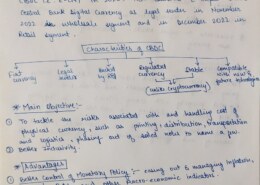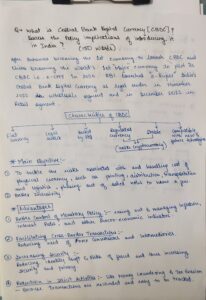How does the central bank control the inflation rates in the country?
Blockchain technology can be defined as a distributed ledger technology for storing information in a manner that makes it tamper-proof. It works on protocols designed to make an agreement among different parties who do not trust each other so that they can work together to achieve different purposesRead more
Blockchain technology can be defined as a distributed ledger technology for storing information in a manner that makes it tamper-proof. It works on protocols designed to make an agreement among different parties who do not trust each other so that they can work together to achieve different purposes which benefit the whole group.
In the current system of banking, blockchain technology can be used to store information in a decentralized manner, making it accessible to all and verifiable by everyone. This technology is permanent, meaning that records or information stored using blockchain technology cannot be lost.
The advantages of blockchain technology in the current system of banking include:
- Open: Anyone can become a participant in the contribution to blockchain technology without requiring permission from anybody.
- Verifiable: Blockchain technology allows everyone to verify the correctness of the information using zero-knowledge proof.
- Permanent: Records or information stored using blockchain technology are permanent and cannot be lost.
- Free from Censorship: Blockchain technology is free from censorship as it does not have control of any single party.
- Tighter Security: Blockchain uses hashing techniques to store each transaction on a block that is connected to each other, making it more secure.
- Cost Reduction: Blockchain reduces the cost for businesses and gives trust to the other partner.
Here are the disadvantages of blockchain technology in the current system of banking:
- Scalability Issues: Blockchain technology is still in its early stages, and it faces scalability issues. It can only process a limited number of transactions per second, which can lead to congestion and slow down the system.
- Regulatory Uncertainty: The regulatory environment for blockchain technology is still unclear, and it can create uncertainty for banks and financial institutions that want to adopt this technology.
- Interoperability: Different blockchain platforms have different protocols, which can make it difficult for them to communicate with each other. This can create interoperability issues and limit the potential of blockchain technology.
- Energy Consumption: The process of mining, which is used to validate transactions on a blockchain, consumes a lot of energy. This can lead to environmental concerns and increase the cost of transactions.
- Security Risks: While blockchain technology is secure, it is not immune to security risks. Hackers can still find ways to exploit vulnerabilities in the system, and there have been instances of hacking and theft of cryptocurrencies.




The central bank, in most countries, plays a crucial role in managing the nation's inflation rate. The process of inflation management involves a combination of monetary and fiscal policies, as well as communication with the public. Here's an overview of how the central bank manages the nation's infRead more
The central bank, in most countries, plays a crucial role in managing the nation’s inflation rate. The process of inflation management involves a combination of monetary and fiscal policies, as well as communication with the public. Here’s an overview of how the central bank manages the nation’s inflation rate:
- Inflation Targeting: The central bank sets an inflation target, usually a specific percentage (e.g., 2% annual inflation rate) and communicates it publicly. This targets helps to anchor inflation expectations and guide monetary policy decisions.
- Monetary Policy Tools: The central bank uses various monetary policy tools to influence the money supply and interest rates:
- Interest Rates: Adjusting short-term interest rates to influence borrowing costs and consumption/spending.
- Reserve Requirements: Regulating the minimum reserve requirements for commercial banks to influence the amount of credit available in the economy.
- Open Market Operations: Buying or selling government securities on the market to inject or absorb liquidity.
- Forward Guidance: The central bank communicates its future policy intentions and expectations to shape market expectations and influence long-term interest rates.
- Inflation-Forecasting Models: The central bank uses statistical models to forecast inflation, taking into account various factors such as GDP growth, unemployment, and commodity prices.
- Monetary Policy Committee (MPC): In many countries, a committee consisting of central bank officials and external experts meets regularly to discuss and decide on monetary policy. The MPC reviews economic data, discusses scenarios, and sets interest rates accordingly.
- Communication: The central bank regularly communicates its decisions, forecasts, and views on the economy to the public through press conferences, statements, and publications (e.g., minutes of MPC meetings).
See less